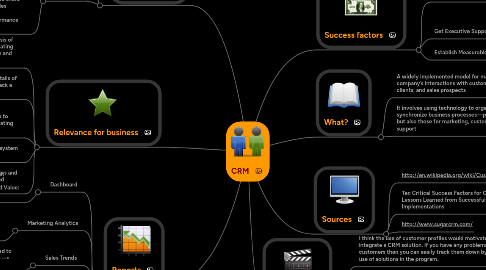
1. Functionality
1.1. Marketing Page
1.1.1. Sugar closes the loop between marketing and sales. Create, execute and track campaigns across multiple channels. Develop compelling email marketing programs and capture leads directly into Sugar with web-to-lead forms. Manage and assign leads to your sales reps and track the marketing ROI of your programs.
1.2. Sales Page
1.2.1. Allows sales representatives to track and share contacts and opportunities, manage and upsell into accounts, manage quotes and contracts, and integration with other apps.
1.2.2. Sugar drives sales force performance by allowing you to share sales data, build repeatable sales processes, reduce sales cycles by focusing on profitable deals, automate sales reporting and forecasting, and monitor business performance metrics.
2. Relevance for business
2.1. A CRM system consists of a historical view and analysis of customers.This helps in reduced searching and correlating customers and to foresee customer needs effectively and increase business.
2.2. CRM contains each and every bit of details of a customer, hence it is very easy for track a customer.
2.3. In CRM system, customers are grouped according to different aspects, to the type of business they do or a to physical location. This helps in focusing and concentrating on each and every customer separately.
2.4. All the details in CRM system is kept centralized.
2.5. Efficiently dealing with all the customers and providing them what they actually need increases the customer satisfaction.
3. Reports
3.1. Dashboard
3.1.1. Provides employees and managers with real-time information about leads, opportunities and accounts. --> Added Value: Yes
3.2. Marketing Analytics
3.2.1. Allows companies to measure the effectiveness of marketing campaigns from the initial offer to a closed sales opportunity --> Added Value: Yes
3.3. Sales Trends
3.3.1. Gives sales managers the insight needed to adjust to changing business conditions --> Added Value: Yes
3.4. Case Reports
3.4.1. Monitor customer problems and how well your customer support team is solving these issues --> Added Value: Yes
3.5. Customer Profiles
3.5.1. Better understanding of who your customers are --> Added Value: Yes
4. What?
4.1. A widely implemented model for managing a company’s interactions with customers, clients, and sales prospects
4.2. It involves using technology to organize, automate, and synchronize business processes—principally sales activities, but also those for marketing, customer service, and technical support
5. Success factors
5.1. Let Business Goals Drive Functionality
5.1.1. If a feature doesn't really help the company forward then scrap it
5.1.2. Improve profitability, reduce costs,...
5.2. Get Executive Support Up Front
5.2.1. Management must actively support projects
5.3. Establish Measurable Business Goals
5.3.1. Very important to define goals
